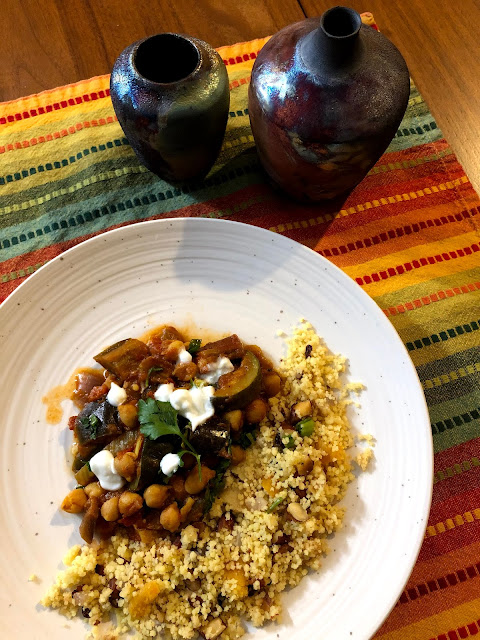In the midst of dizzying change, cities on fire, and a virus on the loose, it's... weird... to post a tagine recipe. But since virtually no one reads this blog anyway, and since food and cooking are my main way of coping with anxiety, this post happened. Flippant towards the state of the world, perhaps, but maybe we need comfort food right now.
I inherited this beautiful ceramic tagine from a colleague who was packing up to move overseas. It has been sitting on top of my fridge for a year, gathering dust, and today it finally embarked on its maiden voyage.
Rather than follow a single recipe, my tagine riffed off of several different recipes, none of which involved the beautiful layering that is common for this dish. All the recipes I found used the tagine much more like a crock pot, and in retrospect I don't think any of the online recipes were really Moroccan. So consider this a first experiment, with more glamorous tagines to follow once I get my hands on a proper Moroccan cookbook.
 |
| That raku is homemade, too! |
Eggplant and chickpea tagine
with apricot couscous
Ingredients (guesstimated as always)
1 red onion, chopped coarsely
4 cloves garlic, sliced
1 eggplant, coarse chunks
1 zucchini, coarse chunks (optional)
1/2 fennel bulb, sliced
1 cup dried chickpeas, cooked in advance, OR 1 can chickpeas (include some cooking water)
1 1/2 cans diced tomatoes
3 dates, thinly sliced
harissa to taste (depends on preferred spice level)
1-2 tsp ras el hanout (this depends on the strength of your spice mix)
2-3 pieces preserved lemon, thinly sliced*
olive oil
at the end
chopped parsley, mint, cilantro
salt to taste
*I'm lucky to have a jar of homemade preserved lemons on hand, but if you don't have any, you can either substitute a squeeze of lemon juice at the end, OR consider making the "quick preserved lemons" in Ottolenghi's Jerusalem cookbook, which are ready in a day instead of the usual 4 weeks of fermentation.
If you don't have ras el hanout—which varies widely in flavor because it simply means "house spice blend"—you can use cinnamon, cumin, and turmeric to get the basic flavor across. Or you can get fancy and make your own.
Method
Place the tagine onto the heat diffuser and turn to medium heat. Fry the onions in olive oil for a few minutes. Add the garlic and eggplant and cook until eggplant starts to soften at the edges. Add spices and fry for a couple minutes more, then add remaining ingredients, including some of the chickpea cooking water to thicken the stew. You can either layer them or stir them together as I did (amateurishly). Salt to taste—careful, the preserved lemons are very salty already—and close up the tagine. Turn the heat on medium low or low, depending on the strength of your stovetop. Cook for anywhere from 2-4 hours.
My stovetop doesn't seem to work on "low" (eyeroll) so I had to turn up the heat to medium and simmer it harder than I normally would. And you're not supposed to take the lid off, like I do here. But it's torture not to take a little peek.
When the tagine is done, scatter it with herbs and serve with yogurt and/or goat cheese (both for me, please!).
For those who want to make the apricot couscous, I used this recipe, which was ok-ish. If I make it again, I'll use salt water instead of broth, since that savory flavor overshadowed the almonds and apricots.
 |
| I'm starving. What's for dinner? |



No comments:
Post a Comment